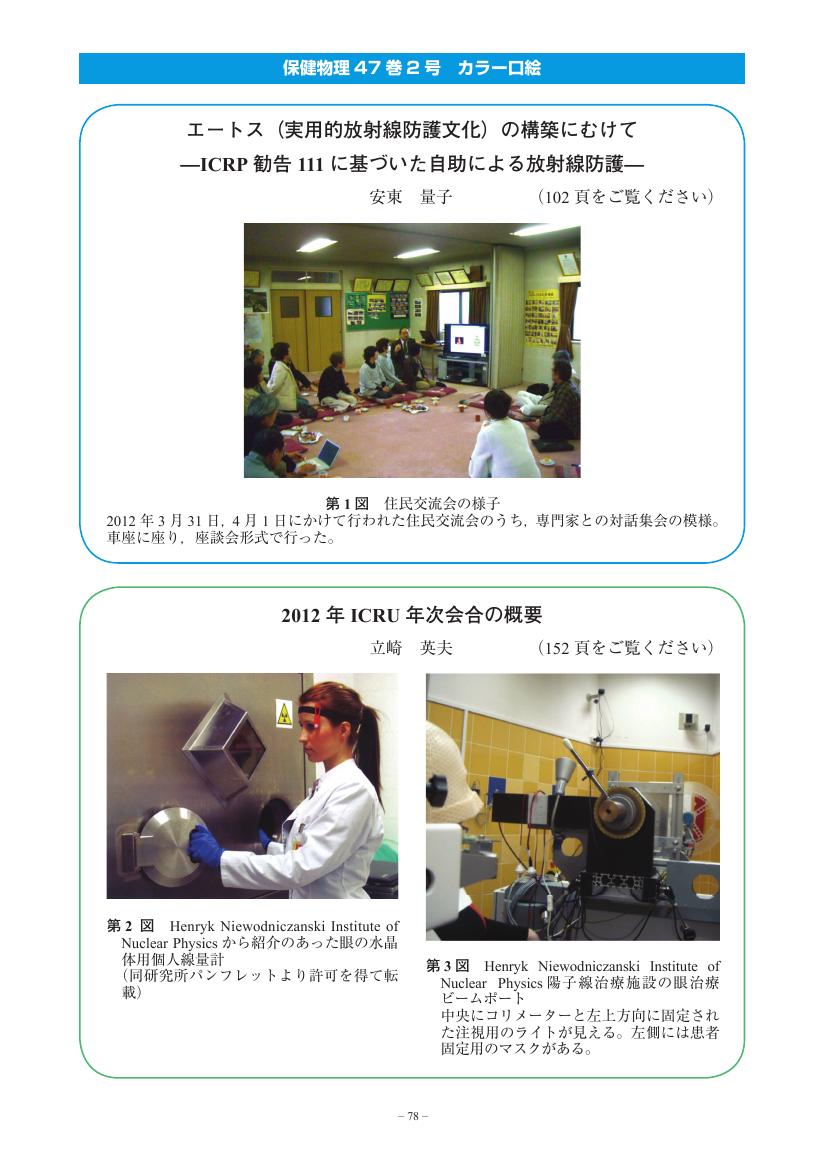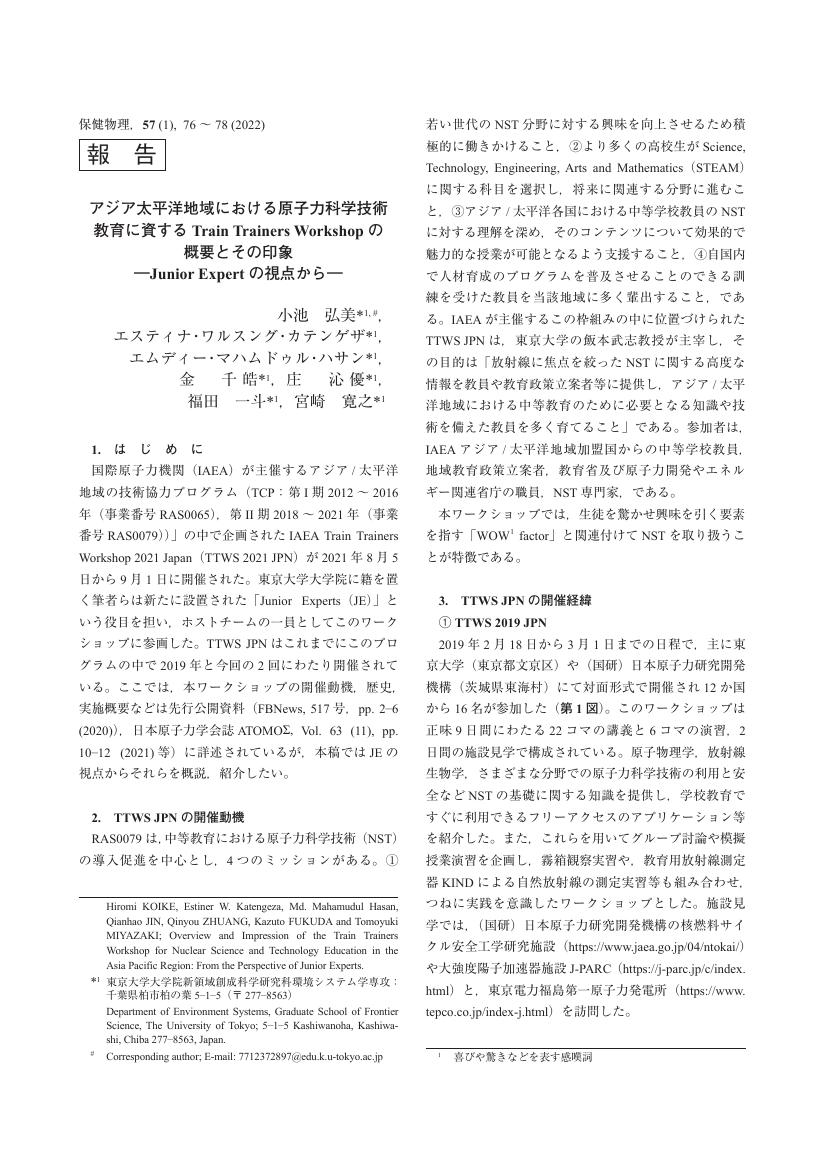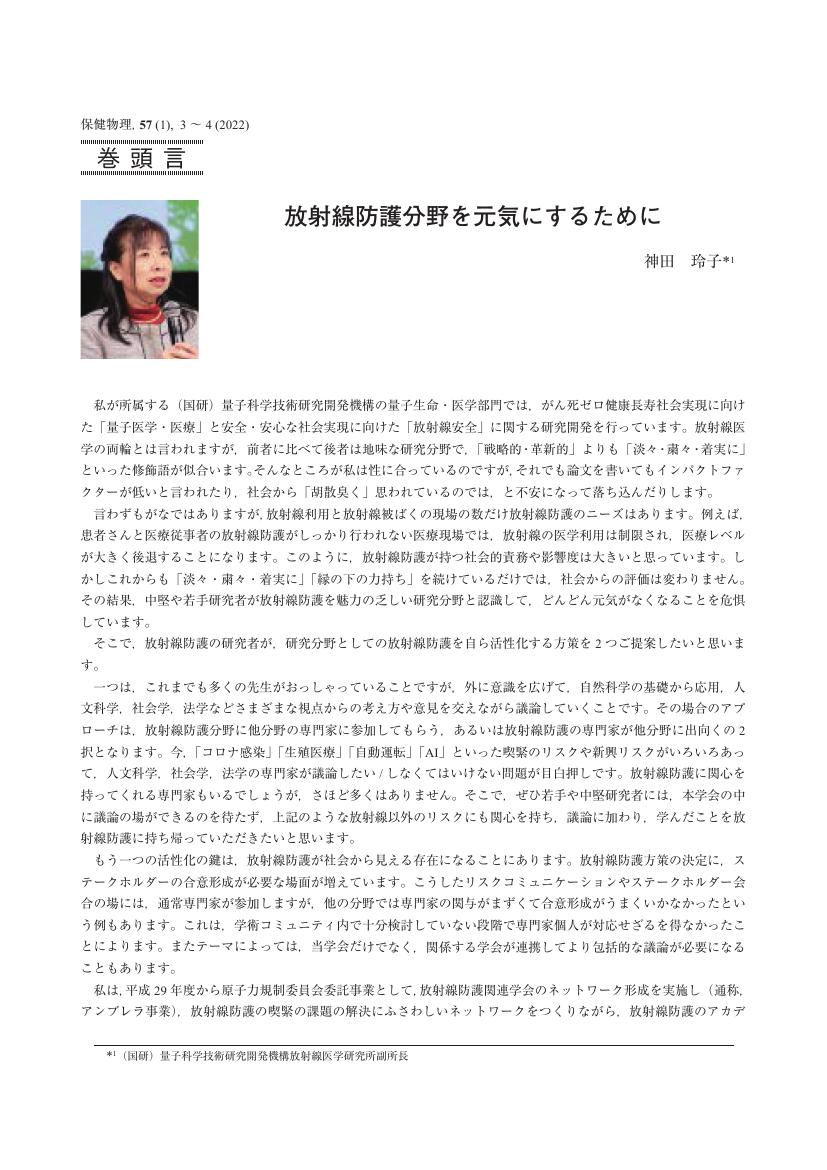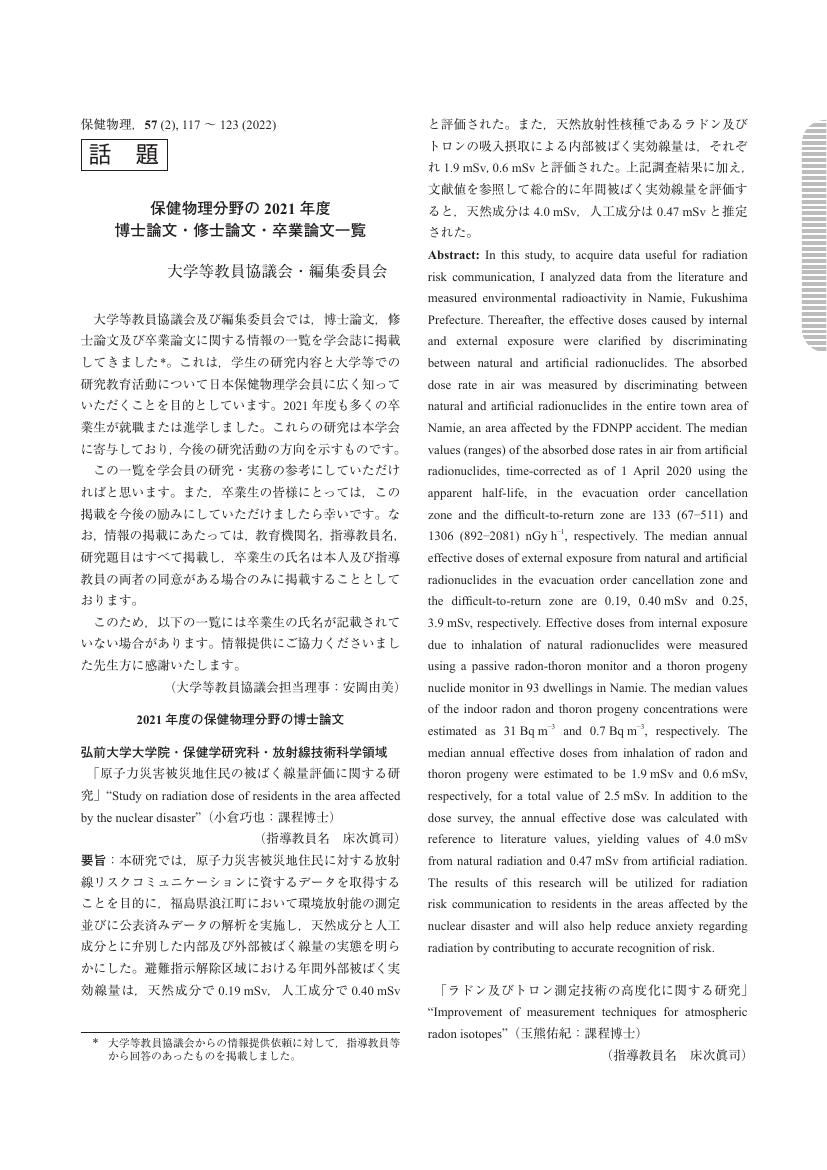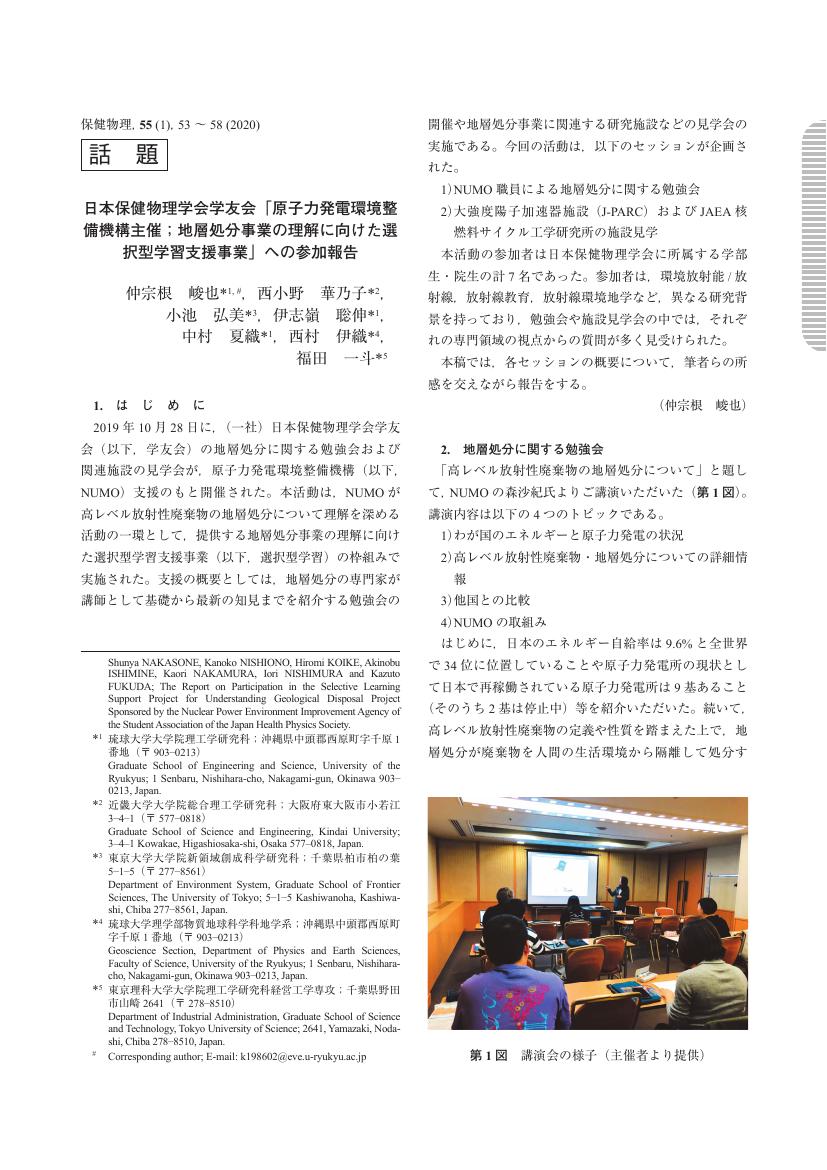2 0 0 0 OA 「常陽」の実績から考察した高速炉の放射線管理
2 0 0 0 OA エートス(実用的放射線防護文化)の構築にむけて
- 著者
- 安東 量子
- 出版者
- 日本保健物理学会
- 雑誌
- 保健物理 (ISSN:03676110)
- 巻号頁・発行日
- vol.47, no.2, pp.78-78, 2012 (Released:2012-12-07)
2 0 0 0 話題 ICRP新勧告案検討目的の韓国,中国訪問
- 著者
- Shymal Ranjan CHAKRABORTY Abdus Sattar MOLLAH Aleya BEGUM Gias Uddin AHMAD
- 出版者
- 日本保健物理学会
- 雑誌
- 保健物理 (ISSN:03676110)
- 巻号頁・発行日
- vol.40, no.2, pp.191-201, 2005 (Released:2010-08-05)
- 参考文献数
- 21
- 被引用文献数
- 5
The activity concentration levels of 232Th, 238U, 40K and 137Cs in drinking water of different locations of Bangladesh were measured by using a high purity germanium (HPGe) detector. The average activity levels with one standard deviation (1σ) of 232Th, 238U and 40K were found to be 250±52mBq/L-1, 157±30mBq/L-1 and 9±3Bq/L-1, respectively. The 137Cs was detected only in 32% samples with an average 4±0.8Bq/L-1. A good correlation between the activities of 232Th and 238U was found. The radium equivalent activity (Raeq) and the representative level index (Iγr) due to natural radionuclides were also calculated. The average Raeq was found to be 1, 212±303mBq/L-1 and the average Iγr was found to be 10±3mBq/L-1. The annual individual committed effective dose (HE) due to intake of radionuclides in water was also evaluated and the average value was found to be 74±21μSv. The distribution of radionuclides was found to be normal except 137Cs. The radioactivity levels of these radionuclides were comparable to the corresponding reported values of drinking water of different countries. The results presented in this study may helpful in establishing a regulatory limit on radioactivity in drinking water in Bangladesh.
2 0 0 0 OA 原子力あるいは放射線緊急事態における各国の短期防護措置の現状
- 著者
- 木村 仁宣 本間 俊充
- 出版者
- 日本保健物理学会
- 雑誌
- 保健物理 (ISSN:03676110)
- 巻号頁・発行日
- vol.41, no.2, pp.76-87, 2006 (Released:2010-08-05)
- 参考文献数
- 38
- 被引用文献数
- 1
In the event of a nuclear or radiological emergency, short-term countermeasures are implemented. This report summarizes the current status of these countermeasures, such as sheltering, evacuation and iodine prophylaxis in OECD/NEA member countries.
2 0 0 0 OA 沖縄県宮古島における空間γ線線量率の分布
- 著者
- 古川 雅英 床次 眞司
- 出版者
- 日本保健物理学会
- 雑誌
- 保健物理 (ISSN:03676110)
- 巻号頁・発行日
- vol.36, no.3, pp.195-206, 2001 (Released:2010-02-25)
- 参考文献数
- 39
- 被引用文献数
- 4 8
The absorbed dose rate in air because of terrestrial gamma radiation in Miyako-jima, an island that is part of Okinawa Prefecture in the subtropical region of Japan, was estimated at 637 points by in situ measurements with spectrometers equipped with 3″φ×3″NaI (Tl) and 1″φ×2″NaI (Tl) scintillation detectors. The mean, minimum, and maximum dose rates were calculated to be about 79nGy/h, 3nGy/h, and 165nGy/h, respectively. The correlation of the dose rate and geology showed that the high-rate areas (>100nGy/h) and the distribution of the Holocene red soils (Onokoshi Clay) overlap each other. On the other hand, the low dose rates (<30nGy/h) were mainly found in an outcrop of the Pleistocene Ryukyu Limestone, the main geologic element in the foundation of the red soils. Recent studies (e. g., Inoue et al., 1993) concluded that most of the red soils were not residuals from the base rocks, but of eolian dust “Kosa (Yellow Sand)” origin. These results strongly indicate that the dose rate in Miyako-jima has been enhanced as a result of eolian deposits transported mainly from the arid region of China since the last glacial epoch.
2 0 0 0 青森県における乳幼児の食品摂取の実態
- 著者
- 五代儀 貴
- 出版者
- 日本保健物理学会
- 雑誌
- 保健物理 : hoken buturi (ISSN:03676110)
- 巻号頁・発行日
- vol.39, no.3, pp.220-230, 2004-09-01
- 参考文献数
- 16
- 被引用文献数
- 1 1
We are collecting sociological data in relation to the estimation of radiation dose by radionuclides released from the nuclear fuel cycle facilities in Rokkasho-mura, Aomori Prefecture. This survey on the daily food intake by infants in Aomori Prefecture over a two-year period (1995-1996) is a continuation of a previous survey on individuals (≥5 years old). We investigated 179 infants in the age group around 4 years old and 181 infants in the age group around 1 year old. They were living in families belonging to three different groups of primary occupations: fishery workers, farmers and other occupations. The average total daily food consumption of the age group around 4 years old was about 958 grams/day/person (g/d/p), which was weighted according to the number of families in each of the three types of occupations in Aomori Prefecture. There was no significant difference shown for occupation and area. The consumption rates of marine, agricultural and livestock products and other products were around 45, 388, 256 and 268g/d/p, respectively. Families of fishery workers showed a higher consumption of marine products, and families of farmers showed a higher consumption of agricultural products. The average total daily food consumption of the age group around 1 year old was about 627g/d/p. The consumption rates of marine, agricultural and livestock products and other products were around 26, 251, 201 and 150g/d/p, respectively. Compared with individuals over 5 years old, food consumption of the age group around 4 years old was about one-half, and the age group around 1 year old was about one-third. Consumption rates of marine products and agricultural products were low, and livestock products and other products were high in infants. As the age group became lower, the ratio of the quantity of dairy products became higher.
- 著者
- 實重 宏明
- 出版者
- 日本保健物理学会
- 雑誌
- 保健物理 : hoken buturi (ISSN:03676110)
- 巻号頁・発行日
- vol.40, no.3, pp.277-281, 2005-09
2 0 0 0 OA 3. 最近の放射線生物影響研究から
- 著者
- 田ノ岡 宏
- 出版者
- 日本保健物理学会
- 雑誌
- 保健物理 (ISSN:03676110)
- 巻号頁・発行日
- vol.32, no.1, pp.9-12, 1997 (Released:2010-02-25)
- 参考文献数
- 20
- 著者
- 反町 篤行 床次 眞司 Miroslaw JANIK 石川 徹夫 Sarata K. SAHOO 吉永 信治 米原 英典 酒井 一夫 山澤 弘実 秋葉 澄伯 古川 雅英 Quanfu SUN Yong-Jae KIM Supitcha CHANYOTHA Rakesh C. RAMOLA
- 出版者
- 日本保健物理学会
- 雑誌
- 保健物理 (ISSN:03676110)
- 巻号頁・発行日
- vol.45, no.1, pp.15-18, 2010 (Released:2011-02-04)
- 参考文献数
- 4
- 被引用文献数
- 1 1 1
2 0 0 0 OA 飲用水とともに摂取したラドンの体内挙動(第2部 : 和文)
- 著者
- 細田 正洋 石川 徹夫 床次 眞司 金賀 愛子 伊藤 亮輔 内田 直希 荻原 俊輔 笠 喜洋 川内 隆行 石井 忠
- 出版者
- 日本保健物理学会
- 雑誌
- 保健物理 : hoken buturi (ISSN:03676110)
- 巻号頁・発行日
- vol.42, no.3, pp.221-226, 2007-09
The bio-kinetics of radon ingested from drinking water was investigated for eight Japanese subjects. A whole-body counter at National Institute of Radiological Sciences (NIRS) was used for the measurement of the ^<214>Bi transfer half-life from the stomach to the small intestine. The transfer half-life seemed to be affected by water quality (chemical/physical properties) as well as the meal ingested before the experiments. The shortest transfer half-life among the subjects was about 50 minutes. During the whole-body counting, the air expired by the subjects was sampled and its radon concentration was measured using two ionization chambers. The changes in radon concentration in the expired air could be classified into three patterns. (1) It decreased with time after ingestion. (2) A peak appeared at the 15 minutes after ingestion. (3) A peak appeared at the 25 minutes after ingestion. These patterns seemed to be related to the ^<214>Bi transfer half-life and the amount of ingested water.
- 著者
- Wrixon Anthony D.
- 出版者
- 日本保健物理学会
- 雑誌
- 保健物理 : hoken buturi (ISSN:03676110)
- 巻号頁・発行日
- vol.39, no.2, pp.119-129, 2004-06
The concept of exemption has been widely used in radiological protection. It is part of the regulator's arsenal for applying legislative requirements in a graded fashion, to avoid the expenditure of effort on situations where the return in terms of improvement in protection would otherwise be trivial. Nevertheless, it still remains a controversial matter. Perhaps some-what surprisingly, it is not so much the dosimetric criteria for exemption that cause debate; it is more the way in which the concept is used; the scenarios employed to calculate derived activity concentrations, and its relationship to the somewhat analogous concept of exclusion. Much of the debate regarding the use of the concept and its relationship with exclusion finds its origin in the national legislative culture that has developed over the years in various countries and the inevitable resistance to keep pace with the evolution of the system of radiological protection as recommended by the International Commission on Radiological Protection and implemented through the International Basic Safety Standards for Protection against Ionizing Radiation and for the Safety of Radiation Sources. A particular problem has been the full integration into the legislative system of protection of exposures to radiation from sources of natural origin and the degree to which exemption is a relevant concept for dealing with such situations. The purpose of this paper is to attempt to provide some clarity on the two concepts and their practical implementation with a view to encouraging international harmonization and avoiding further unnecessary debate.
1 0 0 0 OA 放射性物質により汚染された災害廃棄物の道路への再利用に伴う被ばく線量評価
- 著者
- 澤口 拓磨 武田 聖司 木村 英雄 田中 忠夫
- 出版者
- 日本保健物理学会
- 雑誌
- 保健物理 (ISSN:03676110)
- 巻号頁・発行日
- vol.50, no.1, pp.36-49, 2015 (Released:2015-12-18)
- 参考文献数
- 34
- 被引用文献数
- 1 3
It is desirable that the disaster wastes contaminated by radioactive cesium after the severe accident at the Fukushima Nuclear Plant are reused as much as possible in order to minimize the quantity to be disposed of. Ministry of the Environment showed the policy that the wastes containing cesium of higher concentration than the clearance level (100 Bq/kg) were reusable as materials of construction such as subbase course materials of pavements under controlled condition with measures to lower exposure doses. In this study, in order to provide technical information for making a guideline on the use of contaminated concrete materials recycled from disaster wastes as pavement, doses for workers and the public were estimated, and the reusable concentration of radioactive cesium in the wastes was evaluated. It was shown that the external exposure of the public (children) residing near the completed pavement gave the minimum radiocesium concentration in order to comply with the dose criteria. The recycled concrete materials whose average concentration of cesium lower than 2,700 Bq/kg can be used as the subbase course materials of pavements.
1 0 0 0 OA 実効線量に関する最新のICRP勧告:ICRP Publication147の解説
- 著者
- 甲斐 倫明
- 出版者
- 日本保健物理学会
- 雑誌
- 保健物理 (ISSN:03676110)
- 巻号頁・発行日
- vol.56, no.3, pp.133-144, 2021-10-12 (Released:2022-01-06)
- 参考文献数
- 29
The International Commission on Radiological Protection (ICRP) has published a report of ICRP Publication 147. This publication has consolidated and expanded the concept of effective dose developed by ICRP. Effective dose has been used as a valuable tool for use in the optimization of protection and retrospective demonstration of compliance for regulatory purpose. The use of equivalent dose should be discontinued to avoid confusion of the same unit of Sievert between effective dose and equivalent dose and to set the limits on organ/tissue doses to prevent tissue reactions. The ICRP has considered effective dose an approximate indicator of possible risk of stochastic effects at low doses below 100 mSv. The estimate of effective dose can be used for comparing medical exposures among different diagnostic modalities including computed tomography and nuclear medicine. However, it is emphasized that use of effective dose is not substitute for the risk of a specific individual/organ since there is an uncertainty of the risk estimate due to low doses and simplified concept using tissue weighting factors that are averaged across all ages and both genders for hypothetical populations. The present article provides a brief summary and commentary of the key issues on the report. The concept of detriment behind calculation of tissue weighting factors in effective dose is reviewed.
- 著者
- 小池 弘美 エスティナ・ワルスング・ カテンゲザ エムディー・マハムドゥル・ ハサン 金 千皓 庄 沁優 福田 一斗 宮崎 寛之
- 出版者
- 日本保健物理学会
- 雑誌
- 保健物理 (ISSN:03676110)
- 巻号頁・発行日
- vol.57, no.1, pp.76-78, 2022-03-31 (Released:2022-05-26)
1 0 0 0 OA 放射線防護分野を元気にするために
- 著者
- 神田 玲子
- 出版者
- 日本保健物理学会
- 雑誌
- 保健物理 (ISSN:03676110)
- 巻号頁・発行日
- vol.57, no.1, pp.3-4, 2022-03-31 (Released:2022-05-26)
1 0 0 0 OA 保健物理分野の2021年度博士論文・修士論文・卒業論文一覧
- 著者
- 大学等教員協議会 ・編集委員会
- 出版者
- 日本保健物理学会
- 雑誌
- 保健物理 (ISSN:03676110)
- 巻号頁・発行日
- vol.57, no.2, pp.117-123, 2022-09-02 (Released:2022-10-19)
1 0 0 0 OA 若手研・学友会における社会コミュニケーション活動報告 ─千葉市科学フェスタ─
1 0 0 0 OA 新しいラドン線量換算係数を考える
- 著者
- 床次 眞司
- 出版者
- 日本保健物理学会
- 雑誌
- 保健物理 (ISSN:03676110)
- 巻号頁・発行日
- vol.53, no.4, pp.282-293, 2018 (Released:2019-03-03)
- 参考文献数
- 59
- 被引用文献数
- 3 6
New dose conversion factors (DCF) for radon progeny inhalation have been presented in the latest ICRP publication 137. There used to be a large difference in the DCF between those derived from epidemiological (ICRP 65) and from dosimetric approaches (ICRP 66). In parallel, UNSCEAR has presented their own DCF. The UNSCEAR DCF fell in the two results given by ICRP. This revision results in a higher DCF than before. This is based on the recently new scientific findings obtained by pooled analyses of epidemiological data from European studies on residential radon and lung cancer. Although the publication 137 is used only for occupational exposures, it will be able to be applied because of the consistency. For occupational exposures the new DCF is two times higher than the previous value and is estimated to be 17 nSv per Bq h m-3. It may be different from the previous one by a factor of more than 3 for public exposures (approximately 21 nSv per Bq h m-3). Using the mean indoor radon concentration in Japan, an annual effective dose due to radon progeny inhalation indoors is estimated to be 0.9 mSv a-1. As the DCF is calculated according to aerosol characteristics, site-specific DCFs can be provided.

